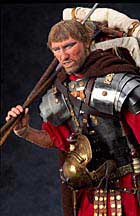
Robert Garland
Colgate University
M.A., McMaster University Ph.D., University College London
Robert S.J. Garland, the Roy D. and Margaret B. Wooster Professor of the Classics at Colgate University, is Director of the Division of the Humanities there and has served 13 years as Chair of the Department of the Classics. He earned his B.A. in Classics from Manchester University, his M.A. in Classics from McMaster University, and his Ph.D. in Ancient History from University College London.
A former Fulbright Scholar and recipient of the George Grote Ancient History Prize, Professor Garland has educated students and audiences at a variety of levels. In addition to his 17 years teaching Classics at Colgate University, he has taught English and Drama to secondary school students and lectured at universities throughout Britain as well as the British School of Archaeology in Athens.
Professor Garland is the author of numerous articles in both academic and popular journals and books capturing details of all aspects of ancient Greek and Roman life, including The Greek Way of Life: From Conception to Old Age; Introducing New Gods: The Politics of Athenian Religion; and Daily Life of the Ancient Greeks. His expertise has been featured in The History Channel's "Last Stand of the 300," and he has repeatedly served as a consultant for educational film companies.
I also noticed that he wrote, "The Eye of the Beholder: Deformity and Disability in the Graeco-Roman World", a "detailed investigation of the plight of those Greeks and Romans who, owing either to deformity or to disability, did not meet their society's exacting criteria for the ideal human form. Drawing on classical drama and poetry, historical works, medical tracts, vase painting and sculpture, mythology, and ethnography, Garland examines the high incidence of disability and deformity among the Greek and Roman population."
This subject really interests me. Recently, I viewed an exhibition of Roman art from the Louvre up at the Seattle Art Museum and was surprised by a reference to Caligula being somewhat deformed since I had never read that before. According to the Louvre, apparently most sculptures of Caligula are idealized and purposefully sculpted to emphasize his relationship to Augustus. The reason I find the idea of a deformed Caligula as somewhat incredulous is that he was adored as a child by the legions and Roman society was not terribly forgiving about physical shortcomings even in childhood - especially if you consider the treatment of Claudius
up at the Seattle Art Museum and was surprised by a reference to Caligula being somewhat deformed since I had never read that before. According to the Louvre, apparently most sculptures of Caligula are idealized and purposefully sculpted to emphasize his relationship to Augustus. The reason I find the idea of a deformed Caligula as somewhat incredulous is that he was adored as a child by the legions and Roman society was not terribly forgiving about physical shortcomings even in childhood - especially if you consider the treatment of Claudius




